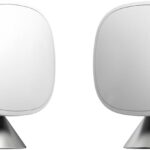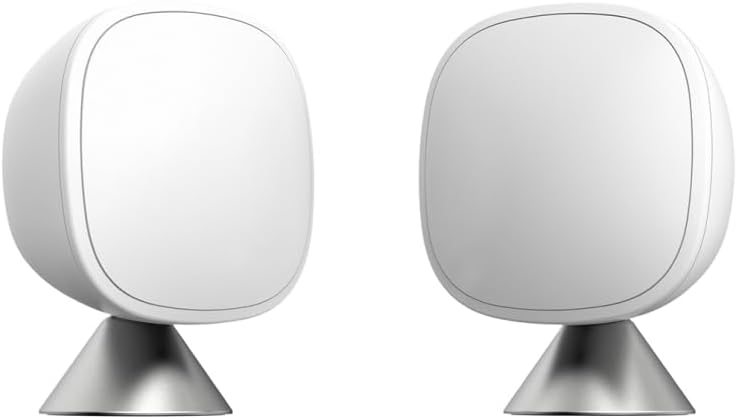Which smart sensor will elevate our home comfort to the next level—Ecobee’s innovative approach or Nest’s user-friendly charm?
In this article, we will compare the Ecobee SmartSensor and the Nest Temperature Sensor to help you decide which is better suited for your smart home needs. With innovative designs and advanced features, both sensors aim to enhance comfort and energy efficiency. Let’s dive in!
Best Comfort
Overall, this sensor enhances the comfort of your home by effectively managing temperature variations. Its seamless integration with Ecobee devices makes it a solid choice for smart home enthusiasts.
Smart Management
This temperature sensor provides a practical solution for managing home temperatures in different rooms. Its user-friendly interface and compatibility with Nest products make it a valuable addition to any smart home setup.
Ecobee Smart Sensor
Nest Temperature Sensor
Ecobee Smart Sensor
Nest Temperature Sensor
Ecobee Smart Sensor
Nest Temperature Sensor
Transform Your Home Comfort: The Ultimate Ecobee Smart Sensor Review!
Design and Build Quality
When it comes to aesthetics and build quality, both the Ecobee SmartSensor and Google Nest Temperature Sensor (2nd Gen) present sleek and unobtrusive designs that blend seamlessly into most home environments.
Ecobee SmartSensor Design
The Ecobee SmartSensor boasts a curved, modern design that is predominantly white, making it visually appealing. It is made from durable plastic and feels solid in hand. The sensor is compact enough to fit discreetly into any room without drawing too much attention, and its mounting options (including wall mounts and detachable stands) give us flexibility in placement. Additionally, it can communicate with the thermostat from up to 60 feet away, even through walls—allowing for optimal placement in larger homes.
Google Nest Temperature Sensor Design
In contrast, the Google Nest Temperature Sensor features a rectangular, glossy finish that feels equally refined. With dimensions of 2.18 x 2.18 x 0.85 inches, it’s slightly bulkier than the Ecobee but remains unobtrusive. The installation process is straightforward, requiring minimal effort, and it can be mounted on a wall. However, its battery life is shorter, and we’ll need to replace it more frequently than the Ecobee, which may require some annoyance for us in terms of maintenance.
Overall, both products deliver solid design and build quality, fitting well within their respective ecosystems while ensuring durability and ease of installation. Each caters to different aesthetic preferences, with Ecobee focusing on functionality linked to range and Nest prioritizing compactness.
Compatibility and Integration
In this section, we’ll evaluate how well each sensor integrates with its respective smart home ecosystems, specifically focusing on the Ecobee SmartSensor and the Google Nest Temperature Sensor (2nd Gen).
Ecobee SmartSensor Compatibility
The Ecobee SmartSensor is designed to pair seamlessly with Ecobee smart thermostats, maximizing its effectiveness in providing comfort and energy savings. Key points include:
Google Nest Temperature Sensor Compatibility
On the other hand, the Google Nest Temperature Sensor is built to work with the latest Nest devices. Here’s what we found:
Overall, while both sensors are well-integrated within their systems, the Ecobee SmartSensor’s compatibility is more limited to Ecobee devices, whereas the Nest Temperature Sensor offers a more user-friendly experience with its app compatibility and broader Nest ecosystem features.
Features and Functionality
Here, we will explore the features offered by each sensor, including smart capabilities, scheduling options, and any unique functionalities. We’ll analyze how these features contribute to energy savings, comfort, and security in our homes.
Ecobee SmartSensor Features
The Ecobee SmartSensor is packed with practical features aimed at enhancing our indoor environment:
Google Nest Temperature Sensor (2nd Gen) Features
On the other hand, the Google Nest Temperature Sensor (2nd Gen) offers its own set of functionalities:
Comparing Energy Efficiency and Comfort
Both sensors strive to create a more comfortable living environment while saving energy:
In conclusion, each product harnesses its features to improve energy efficiency and enhance comfort in unique ways tailored to their respective ecosystems.
Feature Comparison
Pricing and Value for Money
In this final main section, we will compare the pricing of both products while assessing their value for the features they offer. We will discuss customer satisfaction and reviews to determine which product provides better overall value.
Ecobee SmartSensor Pricing
The Ecobee Smart Sensor (2 Pack) is priced around $95. While this price is on the higher side, it offers substantial potential for energy savings and comfort enhancement in our homes through its advanced features. With a battery life of up to five years and effective communication with Ecobee thermostats, this package is aimed at users looking for a robust and long-lasting solution.
Google Nest Temperature Sensor Pricing
In contrast, the Google Nest Temperature Sensor (2nd Gen) is available for about $40. This makes it a more affordable option, particularly for those already using Nest products. Despite its lower price, the sensor still delivers effective temperature control and ease of use.
Customer Satisfaction
In terms of customer reviews, the Ecobee SmartSensor has garnered 8,085 reviews, reflecting strong satisfaction with its performance, earning an overall rating of 8.8/10. The Google Nest Temperature Sensor, while still well-reviewed, has significantly fewer ratings—only 447 reviews, leading to an overall rating of 8.5/10.
Ultimately, while the Ecobee SmartSensor carries a higher price tag, it provides additional features and longer battery life, appealing to those invested in the Ecobee ecosystem. The Nest Temperature Sensor, however, offers compelling performance at a lower cost, making it a great choice for those within the Nest environment.
Conclusion: The Final Verdict
After thoroughly comparing the Ecobee SmartSensor and Google Nest Temperature Sensor (2nd Gen) across design, compatibility, features, and pricing, we recommend the Ecobee SmartSensor as the superior choice for smart home enthusiasts. Its advanced occupancy detection, extended range, and long battery life make it an excellent investment for optimizing home comfort and energy efficiency.
While the Nest Temperature Sensor is more affordable and great for localized temperature control, its limitations and shorter battery life tip the scales in favor of Ecobee. Ready to elevate your smart home? Consider investing in the Ecobee SmartSensor for enhanced comfort and convenience.



Leave a Reply